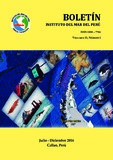Por favor, use este identificador para citar o enlazar este ítem:
https://hdl.handle.net/20.500.12958/3096Registro completo de metadatos
| Campo DC | Valor | Lengua/Idioma |
|---|---|---|
| dc.contributor.author | Salazar Céspedes, Carlos Martín | - |
| dc.contributor.author | Flores Huamán, Oswaldo | - |
| dc.contributor.author | Gonzales Salas, Adolfo | - |
| dc.contributor.author | Cornejo Urbina, Rodolfo | - |
| dc.contributor.author | Paulino Rojas, Carlos | - |
| dc.date.accessioned | 2017-01-30T17:08:30Z | - |
| dc.date.available | 2017-01-30T17:08:30Z | - |
| dc.date.issued | 2016 | - |
| dc.identifier.citation | Bol Inst Mar Perú 31(2), 2016: p. 194-205 | es_ES |
| dc.identifier.uri | https://hdl.handle.net/20.500.12958/3096 | - |
| dc.description.abstract | La evaluación hidroacústica de la distribución y biomasa del krill (E. superba) se efectuó a bordo del BIC Humboldt, en febrero 2013. El área evaluada comprendió el estrecho de Bransfield y las proximidades de la Isla Gibbs totalizando 11.712 mn2. Durante el día se registraron enjambres de krill en altas densidades entre 20 y 50 m de profundidad, durante la noche se detectaron enjambres disgregados y dispersos desde la superficie hasta 20 m de profundidad. Las densidades más altas, se observaron en el extremo oriental del estrecho de Bransfield, seguido de una distribución regular entre las islas Rey Jorge y Gibbs con densidades medias (500-1.000 m²/mn²) y altas (>1.000 m²/mn²). Un núcleo de baja densidad se observó, entre las islas Decepción y Torre. El rango de temperatura de los enjambres de krill estuvo entre -1,0 y 1,5 °C. Las agregaciones de krill se observaron entre 33,96 y 34,35 ups de salinidad. Se estimó una biomasa hidroacústica del krill de 876,368 t mediante el método Stochastic Distorted Wave Approximation (SDWBA). | es_ES |
| dc.description.abstract | ABSTRACT: Hydroacoustic evaluation of the distribution and biomass of krill (E. superba) was held on board the BIC Humboldt, in February 2013. The area evaluated between the Bransfield Strait and near the Gibbs Island totaling 11,712 nm2. During the day, krill swarms were record at high densities between 20 and 50 m deep, during the night dispersed and scattered swarms were detect from the surface to 20 m deep. The highest densities were observe at the eastern end of Bransfield Strait, followed by a regular distribution between the islands King George and Gibbs with average densities (500-1,000 m/mn²) and high (> 1000 m/mn²). A low density core was observed between Deception and Torre islands. The temperature range of the swarms of krill was between -1.0 and 1.5 °C. Aggregations of krill were observe between 33.96 and 34.35 ups salinity. A hydroacoustic biomass of krill 876.368 t was estimated by Stochastic Distorted Wave Approximation (SDWBA) method. | - |
| dc.language.iso | spa | es_ES |
| dc.publisher | Callao | es_ES |
| dc.relation.ispartofseries | Boletín IMARPE;Vol. 31 n° 2, 2016 | - |
| dc.rights | info:eu-repo/semantics/openAccess | es_ES |
| dc.rights.uri | https://creativecommons.org/licenses/by/4.0/ | - |
| dc.source | Instituto del Mar del Perú - IMARPE | es_ES |
| dc.source.uri | Repositorio Digital IMARPE | es_ES |
| dc.subject | Bioacústico | es_ES |
| dc.subject | Krill | es_ES |
| dc.subject | Euphausia Superba | es_ES |
| dc.subject | Estrecho De Bransfield | es_ES |
| dc.subject | Antártida | es_ES |
| dc.title | Estudio bioacústico del krill (Euphausia superba) en el estrecho de Bransfield, Antártida | es_ES |
| dc.title.alternative | Bioacoustic study of krill (Euphausia superba) in the Bransfield Strait, Antartica | es_ES |
| dc.type | info:eu-repo/semantics/article | es_ES |
| Aparece en las colecciones: | Boletín 31(2), 2016 | |
Ficheros en este ítem:
| Fichero | Descripción | Tamaño | Formato | |
|---|---|---|---|---|
| Boletin 31(2)-6.pdf | 4,86 MB | Adobe PDF |  Visualizar/Abrir |
Este ítem está sujeto a una licencia Creative Commons Licencia Creative Commons

